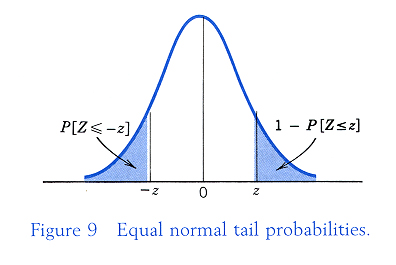Standard Normal Distribution 標準常態分配
The standard normal distribution has a bell-shaped density with mean
 and standard deviation
and standard deviation

The standard normal distribution is denoted by N(0,1) or Z.
- 1.
-
![$P[Z \leq 0]=.5$](img3.gif)
- 2.
-
![$P[Z \leq - z]=1-P[Z\leq z]=P[Z\geq z]$](img4.gif)

標準常態分配的值可以由查標準常態分配表得知.
- 例
- Find
![$P[Z<-1.9 \mbox{ or } Z>2.1]$](img5.gif) .
.
The two events [Z<-1.9] and [Z>2.1] are incompatible, so we add their
probabilities:
![$P[Z<-1.9 \mbox{ or } Z>2.1]=P[Z<-1.9]+P[Z>2.1]$](img6.gif) .
As indicated in follow, P[Z>2.1] is the area to the right of 2.1, which is
.
As indicated in follow, P[Z>2.1] is the area to the right of 2.1, which is
![$1-[\mbox{Area to left of }2.1]=1-.9821=.0179$](img7.gif) .
The normal table gives
P[Z<-1.9]=.0287 directly. Adding these two quantities, we get
.
The normal table gives
P[Z<-1.9]=.0287 directly. Adding these two quantities, we get
![$P[Z<-1.9 \mbox{ or } Z>2.1]=.0287+.0179=.0466$](img8.gif)

![]() and standard deviation
and standard deviation
![]()

